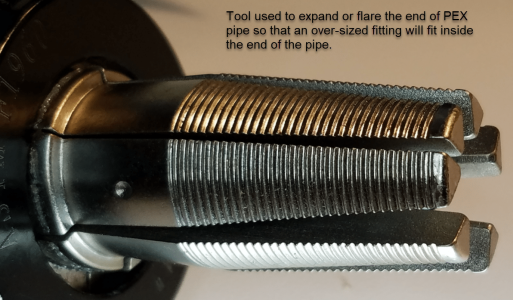If the PEX manufacturer’s installation rules are not followed, failures can result. One of the most common installation defects is sharply bending the pipe to make a directional change. Sharply bending the tubing causes the tubing to kink. The kink in the tubing places localized stress at a spot in the wall of the tubing. Stress in the PEX material facilitates oxidative degradation of the PEX causing it to become brittle at the high-stress point.
A CASE STUDY
The following case study is the property of Plastic Expert Group and cannot be copied or distributed without prior permission. Our case analysis does not imply that this specific plastic failure will happen systematically. Every case is unique and should be treated accordingly.
PROBLEM: PEX Installation defects
PEX offers advantages over other piping products including:
- PEX is flexible allowing it to be bent around corners and to expand without cracking at freezing temperature.
- PEX is much more chemically resistant, compared to CPVC and PVC pipes. For example, contact of CPVC and PVC to contact with some acoustical and fire caulks, some spray foam insulation, some antimicrobial cleaning products, some moldicides, and products containing vegetable oil, will likely cause embrittlement and failure of the pipe. Also, the solvents in the cement used to assemble the fittings are incompatible with the pipe. If too much cement is used to form the joints, the pipes become brittle after a few years leading to failures.
- The use of CPVC and PVC is not recommended for use in hydronic heating/cooling systems as a leak in the refrigeration system, resulting in compressor oil contamination, will destroy the pipe. The improved chemical resistance of PEX allows its use in hydronic systems as a refrigerant leak has little effect on PEX.
- PEX is easy to cut to length using a tubing knife-cutter
- PEX fittings are easy to install using a crimp tool.
However, the tubing must be installed properly.
If the PEX manufacturer’s installation rules are not followed, failures can result. One of the most common installation defects is sharply bending the pipe to make a directional change. Sharply bending the tubing causes the tubing to kink. The kink in the tubing places localized stress at a spot in the wall of the tubing. Stress in the PEX material facilitates oxidative degradation of the PEX causing it to become brittle at the high-stress point.
SOLUTION TO THE PROBLEM
Installation of crimp fittings must be done properly or leaks will occur. The key to making successful crimp joints includes:
- Properly adjusting the crimp tool to end up with the crimp ring at the proper size.
- A go/no-go gage should be used to confirm that every crimp ring is crimped to the right diameter. If a crimp ring is a no-go, it should be cut out and the joint remade. A crimp ring should not be double crimped.
- We recommend against the use of expansion fittings. Expansion of the tubing places high hoop stress on the tubing increasing the likelihood of failure. Also, the tool used to expand the end of the tubing to allow insertion of the expansion fitting damages the inside of the tubing.
CONCLUSION
When leaks occur, a forensic failure analysis should be conducted to determine the root cause of the failure and whether the installation was systemically defective. It is important to determine if the failure was a one-off or if the entire piping system was defectively installed, the entire piping system may need to be replaced.

